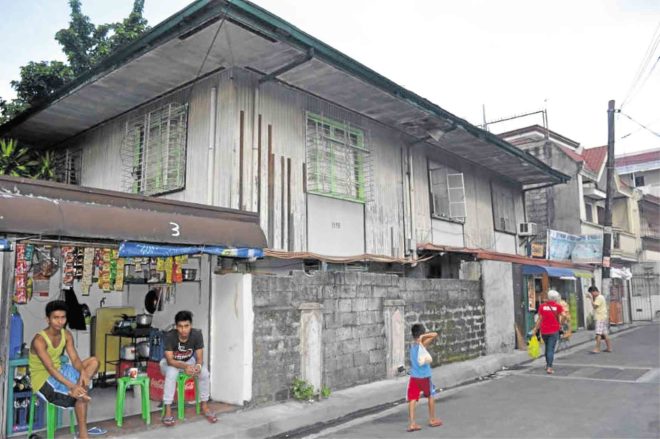
It is now known as Valencia Street, but back when it was still Calle Alix in Sta. Mesa, Manila, its most famous resident lived at address 1598.
He was the son of a master painter who later moved out of the shadow of his great, though controversial, artist-parent and built his name before the war as a master architect.
He was Andres Luna de San Pedro, Juan Luna’s son who designed the Legarda Elementary School in Sampaloc, Manila; Saint Vincent de Paul Church on San Marcelino Street, Manila; Perez-Samanillo Building in Escolta; and Crystal Arcade, also in Escolta, the most modern structure in prewar Manila.
With his American wife Grace, Andres Luna stayed in the American period house on Calle Alix until his death in 1952.
Following Andres’ death, Grace tried to sell the paintings and sketches to the government but failed due to the latter’s possible disinterest as well as budget constraints.
So she brought the collections back with her to New York. After her death, the paintings and sketches were passed on to her friend, Beth Troster. Later the collections found their way back to the Philippines through writer Alberto Florentino and his wife Eva, who arranged for their return with the help of Cubao’s Heritage Art Gallery owner Mario Alcantara.
The paintings were eventually bought by the Far East Bank and Trust Company and are now with the Bank of the Philippine Islands. Some of these are displayed at the National Museum of Fine Arts in Manila.
Some of the documents and important belongings by brothers Juan and Antonio, and Andres, landed at the Heritage Art Gallery, but were all destroyed in a fire caused by lightning.
House of treasures
The house on Calle Alix, which stood on more than 700-sq m of property, sandwiched between the street and the Estero de Valencia, was offered by Grace, with the entire lot, to government tax examiner and assessor of their property, Casimiro Villaran and wife Narcisa Go for P35,000. It was bought by the Villarans at a discounted price of P33,000. This was between 1954 and 1955.
From 1956, Casimiro, Narcisa, and their 10 children lived in the house reminiscent of American period green-and-white wooden houses of Baguio City.
Interestingly, not all of the paintings and sketches were brought by Grace to the US—a number, including easels and other art materials, were left in the Calle Alix house.
Juan Luna’s “La Bulaqueña,” for example, which is now displayed at the National Museum, used to hang in the house.
Felicidad Villaran Gacad, 71, the oldest of the siblings, vividly remembers that piece when they transferred to the house in 1956. But she cannot recall when it was moved out.
Other artworks in the compound when the Villaran family moved in included the concrete medallions featuring Juan Luna and his wife, Paz Pardo de Tavera, which used to hang on the perimeter wall, and the paintings and sketches on three crates.
These medallions, possibly done by Andres Luna, were sold by the Villarans to a family friend.
Gen. Antonio Luna’s bloodied uniform and saber stored inside a box were also in the house. The uniform later found its way to the Heritage but was among those destroyed in the fire.
The house also had an American-era Carlton cooking set and a working table, which are still with the Villarans.
A tokador (dresser) was given to one of the family’s sewers many years ago.
Sprawling property
The compound also used to have a garage which was converted into a garments factory of Narcisa.
It also used to have two gardens with a pond, a driveway and a back gate leading to the estero, which was used before as a transportation route using cascoes just like in the other
estero of Manila.
The two-story house had one bedroom, a terrace, capiz windows, a library on the second level and a studio on the lower level which was converted by the Villarans into a sala.
Renovated in 1967 and 1968, the house, which is now a boarding house for students, still has at least two of its original wooden posts, lintels, back window and adobe gate posts.
Centennial calendar
Andres Luna was commissioned by the government, probably in the early 1950s, to make a calendar for the commemoration of Juan Luna’s centennial birth anniversary in 1957.
But he died before completing the project.
Today, only five prints survived, which are in the possession of Gina Villaran Santiago, 57, one of the Villaran siblings.
These surviving prints, given to Gina by her mother in 2000 after her father died, have the images of Juan Luna’s paintings such as “Puesto del Sol,” “Portrait of a Lady” and “Idilio.”
Accompanying these prints is an unsigned painting of a scene in Europe attributed to Juan Luna, which is also in the possession of Gina.
Unfortunately, aside from a few Luna family belongings and artworks that were saved by the Villaran family, most artworks and related materials were thrown away by the Villarans when they transferred there.
A number of paintings, sketches and other related items in the house were disposed of.
Had they known the importance of those works and materials, the family could have saved those, Felicidad said.
We could have been rich by now, she quipped. —CONTRIBUTED
Author’s note: Information provided by the Villaran siblings Felicidad V. Gacad, 71; Constancia G. Villaran, 67; Cresencia V. Ortiz, 59; Gina V. Santiago, 57; their friend Baby Erorita. Some details are from Ambeth Ocampo’s opinion piece published in the Inquirer in 2015.